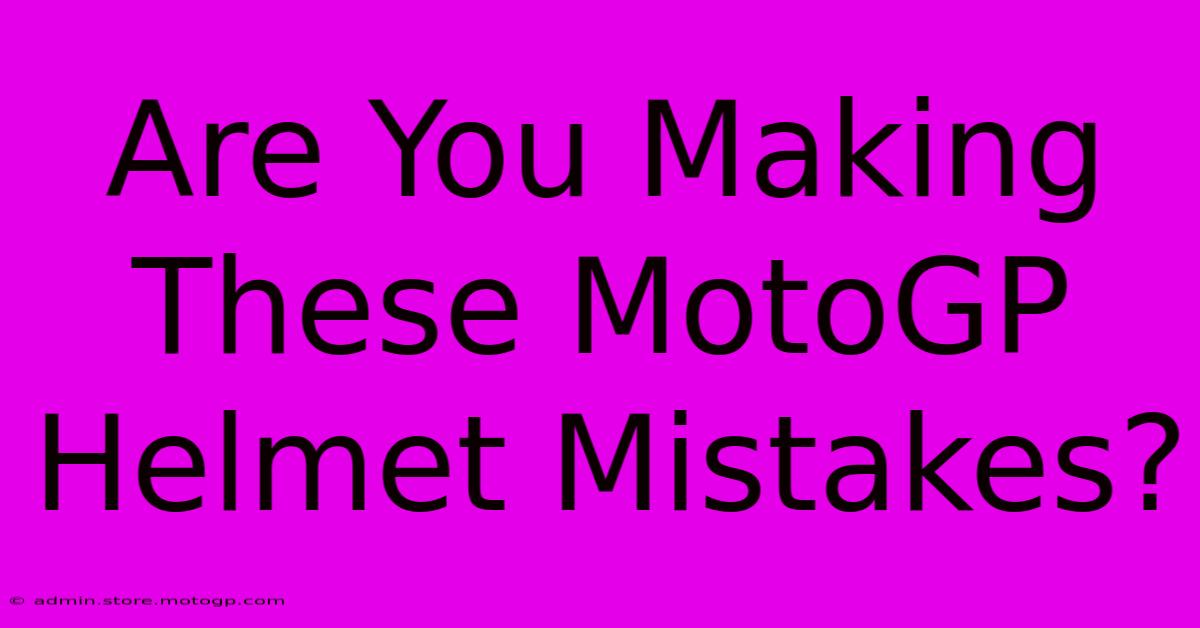Are You Making These MotoGP Helmet Mistakes?

Table of Contents
Are You Making These MotoGP Helmet Mistakes?
MotoGP racing is exhilarating, a high-octane spectacle of skill and speed. But even the smallest detail can mean the difference between victory and a crash. For riders, this extends to their equipment, and particularly their helmets. Are you making mistakes with your own helmet, whether you're a seasoned track day enthusiast or just starting out? Let's explore some common errors and how to avoid them.
Choosing the Wrong Helmet Size
This might seem obvious, but getting the right helmet size is paramount. A helmet that's too large will offer insufficient protection, allowing for excessive movement during impacts. Conversely, a helmet that's too tight restricts blood flow and causes discomfort, leading to fatigue and impaired judgment – a recipe for disaster on the track.
Always try on helmets before purchasing. Don't rely on online size charts alone. Head shapes vary considerably, and a brand's size "large" might fit differently than another's. A professional fitting at a reputable motorcycle retailer is invaluable. Look for a snug but comfortable fit, with no pressure points.
The Impact of an Ill-Fitting Helmet:
- Reduced Protection: Excessive movement inside the helmet increases the risk of head injuries.
- Impaired Vision: A tight helmet can restrict peripheral vision.
- Neck Strain: An improperly fitting helmet adds unnecessary strain to your neck muscles.
- Discomfort and Fatigue: Leading to reduced concentration and increased risk-taking.
Neglecting Helmet Maintenance
Your MotoGP-style helmet is an investment, and it requires regular maintenance to ensure its longevity and effectiveness. Neglecting maintenance compromises safety.
Regular Cleaning: Dirt, sweat, and oil can degrade the helmet's shell and internal components. Use a mild detergent and soft cloth for cleaning, avoiding harsh chemicals. Refer to the manufacturer's instructions for specific cleaning recommendations.
Inspecting the Shell: Check regularly for any cracks, scratches, or dents. Even minor damage can weaken the helmet's structural integrity.
Replacing the Liner: The inner liner absorbs sweat and bacteria. Replace it regularly (frequency varies by manufacturer) to maintain hygiene and comfort. A worn liner reduces the effectiveness of the helmet's shock-absorbing properties.
The Consequences of Neglect:
- Compromised Safety: Damaged helmets offer reduced protection in a crash.
- Reduced Comfort: A dirty liner can lead to skin irritation and discomfort.
- Premature Wear and Tear: Proper maintenance extends the lifespan of your helmet.
Ignoring Helmet Technology
The world of motorcycle helmets is constantly evolving. Ignoring advancements in technology leaves you vulnerable. Modern helmets incorporate features like MIPS (Multi-directional Impact Protection System) and advanced shell construction materials, significantly improving impact protection.
Understanding Helmet Standards: Familiarize yourself with safety standards like Snell and DOT, ensuring your helmet meets the highest safety criteria. Don't compromise on safety.
Exploring Advanced Features: Research features like improved ventilation systems, aerodynamic designs, and enhanced visor mechanisms. These advancements can improve comfort, performance, and safety on the track.
Staying Ahead of the Curve:
- Enhanced Protection: Modern technology offers significantly improved impact absorption.
- Improved Comfort: Advanced features like improved ventilation contribute to rider comfort.
- Increased Performance: Aerodynamic designs can enhance your riding experience.
Failing to Replace Your Helmet
Even the best-maintained helmet has a limited lifespan. Continuing to use an outdated helmet is incredibly risky. Helmets degrade over time due to the cumulative effect of impacts, UV exposure, and general wear and tear. Most manufacturers recommend replacing helmets every 5 years, regardless of their condition.
If your helmet has been involved in a crash, replace it immediately, even if there's no visible damage. Internal structures may have been compromised, compromising its ability to protect you in a future accident.
The Importance of Replacement:
- Reduced Effectiveness: Over time, helmets lose their ability to absorb impacts effectively.
- Safety Concerns: Using an outdated helmet increases the risk of serious injury.
- Peace of Mind: Replacing your helmet provides essential peace of mind.
By avoiding these common mistakes, you can ensure your helmet provides the maximum level of protection, allowing you to focus on what matters most: pushing your limits on the track. Remember, your safety is paramount. Invest in the right gear and maintain it properly. Your next race might depend on it!

Thank you for visiting our website wich cover about Are You Making These MotoGP Helmet Mistakes?. We hope the information provided has been useful to you. Feel free to contact us if you have any questions or need further assistance. See you next time and dont miss to bookmark.
Featured Posts
-
Unleash Your Potential Cota Circuit Days
Feb 20, 2025
-
Get Your Heart Racing F1 Austin Is Calling
Feb 20, 2025
-
Moto Gp Sprint A Spectators Guide
Feb 20, 2025
-
Tnt Sports Moto Gp Schedule Stay Connected To The Track
Feb 20, 2025
-
Cota Grounds Pass Get Closer To The Race
Feb 20, 2025
